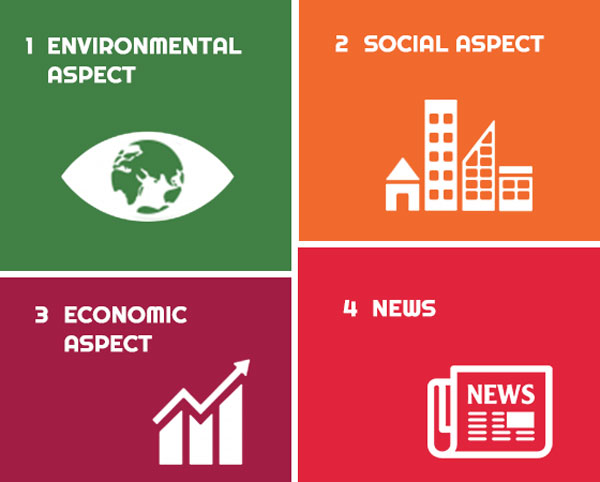The scope of sustainable development is broad, with an analysis of curricula in 78 countries showing that 55% use the term "ecology" and 47% use the term "environmental education" - from global sources Education Monitoring Report.
Generally speaking, sustainable development is mainly divided into the following three aspects.
Environmental Aspect - Resource Sustainability
Environmental factors refer to methods that do not destroy ecosystems or minimize damage to the environment, make rational use of natural resources, attach importance to environmental protection, develop or grow through the use of resources, renew or continue to exist for others, use recycled materials and renewable resources are an example of sustainable development. Encourage reuse, recycling.
Social Aspect
It refers to meeting the needs of human beings without destroying the illusory ecosystem or minimizing the damage to the environment. Sustainable development does not mean returning human beings to primitive society, but balancing human needs and ecological balance. Environmental protection cannot be viewed in isolation. Environmental orientation is the most important part of sustainability, but the main goal is to care for human beings, improve the quality of life, and ensure a healthy living environment for human beings. As a result, a direct link between human living standards and environmental quality is established. The positive goal of sustainable development strategies is to create a biosphere system that can resolve the contradictions of globalization.

Economic Aspect
Refers to must be economically profitable. This has two implications. One is that only economically profitable development projects can be promoted and sustainable; environmental damage, this is not really sustainable development.
Sustainable development emphasizes the need for coordinated development of three elements, promoting the overall progress of society, and the stability of the environment.
News
News from BBC
UN Sustainable Development Goal 12: Responsible production/consumption
Everything we produce and consume has an impact on the environment. To live sustainably we need to reduce the resources we use and the amount of waste we produce. There's a long way to go but there are already improvements and reasons to be hopeful.
Responsible production and consumption worldwide
Sustainable Development Goals
The United Nations have issued 17 ambitious goals to try and build a better, fairer, and more sustainable future for the world.
Sustainable Development Goal 12 aims to ensure that the goods and things we make, and how we make them, are as sustainable as possible.
The UN recognizes that Worldwide consumption and production — a driving force of the global economy — rest on the use of the natural environment and resources in a way that continues to have destructive impacts on the planet.
It is important for all of us to be aware of just how much we consume and what the cost of this consumption is for our local environments and the wider world.
All the goods in our lives are products that have had to be manufactured. This uses raw materials and energy in ways that are not always sustainable. Once goods have reached the end of their usefulness they will have to be recycled or disposed of.
It is important that companies producing all these goods do this responsibly. To be sustainable they need to minimise the raw materials they use and the impact they have on the environment.
And it is up to all of us to be responsible consumers, considering the impact of our lifestyles and choices.
UN Sustainable Development Goal 17: Partnerships for the goals
The UN recognizes the importance of people powered networks which can make a difference implementing the aims of all of the sustainable development goals at both a local and global level.
Partnerships worldwide
Sustainable Development Goals
The United Nations have issued 17 ambitious goals to try and build a better, fairer, and more sustainable future for the world.
Sustainable Development Goal 17 stresses that to address the challenges that our planet faces we will need strong cooperation and partnerships between international institutions and nations.
Partnerships are the glue that holds all the UN’s sustainability goals together. Different people, organizations and countries will need to act together to meet the challenges that the world is facing.
The UN states, "The inter-connected global economy requires a global response to ensure all countries, in particular developing countries, can address the compounding and parallel health, economic and environmental crises to recover better".
Some of the key recommendations of the UN to achieve this goal include:
Wealthy nations assisting developing nations with debt relief
Promoting finanical investment in developing countries
Making environmentally friendly technology available to developing countries
Significantly increase the exports from developing countries to help bring more money into these nations
News from International Bamboo Bureau
"Bamboo instead of plastic" leads green development
The international community has successively introduced policies to ban and limit plastics, and put forward a timetable for banning and restricting plastics. At present, more than 140 countries have clearly established relevant policies. The Ministry of Ecology and Environment of the National Development and Reform Commission of China stated in the "Opinions on Further Strengthening the Control of Plastic Pollution" issued in January 2020: "By 2022, the consumption of single-use plastic products will be significantly reduced, alternative products will be promoted, and plastic waste will be recycled. The proportion of energy utilization has been greatly increased." The British government began to promote a new "plastic restriction order" in early 2018, which completely banned the sale of disposable plastic products such as plastic straws. The European Commission proposed a "plastic restriction order" plan in 2018, proposing straws made of more environmentally friendly and sustainable materials to replace plastic straws. Not only disposable plastic products, but the entire plastic products industry will face major changes, especially the recent surge in crude oil prices, and the low-carbon transformation of the plastic products industry is imminent. Low carbon materials will become the only way to replace plastics.



